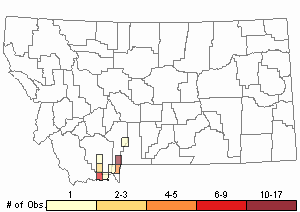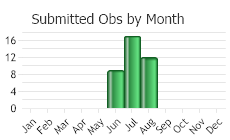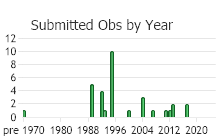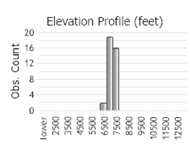View in other NatureServe Network Field Guides
NatureServe
Montana
Utah
Wyoming
Idaho
Wisconsin
British Columbia
South Carolina
Yukon
California
New York
Large-leaved Balsamroot - Balsamorhiza macrophylla
State Rank Reason (see State Rank above)
This species occurs in Montana at the edge of its range where it is known from three southwestern Montana mountain ranges. Most of the known populations are moderate to large in size and in generally good-quality habitat. One occurrence in Gallatin County is only known from a 1931 collection. Invasive weeds are not a problem at sites occupied by Balsamorhiza macrophylla and livestock grazing at some of the sites does not appear to be negatively impacting the species.
- Details on Status Ranking and Review
Population Size
Score1 - Moderate: Generally 10,000-100,000 individuals.
Range Extent
Score1 - Peripheral, Disjunct or Sporadic Distribution in MT: Widespread species that is peripheral, disjunct or sporadically distributed within MT such that it occurs in <5% of the state (<7,500 sq. miles or the combined area of Beaverhead and Ravalli Counties) or is restricted to 4-5 sub-basins.
CommentPeripheral and sporadically distributed in southwest Montana.
Area of Occupancy
Score2 - Low: Generally occurring in 4-10 Subwatersheds (6th Code HUC’s).
Environmental Specificity
Score1 - Moderate: Species is restricted to a specific habitat that is more widely distributed or to several restricted habitats and is typically dependent upon relatively unaltered, good-quality habitat (C Values of 5-7).
Trends
ScoreNA - Rank factor not assessed.
CommentTrends are unknown, though populations are likely stable or experiencing only minor declines.
Threats
Score0-1 - Low to Medium.
Intrinsic Vulnerability
Score0-1 - Low to Moderate Vulnerability.
Raw Conservation Status Score
Score
5 to 7 total points scored out of a possible 16 (Rarity factors and threats only).
General Description
Large-leafed Balsamroot is a large perennial with a well-developed taproot and a branched, underground rootcrown. The leafless flowering stems are 30-100 cm tall; the larger basal leaves are 30-60 cm long and pinnately divided into entire-margined or coarsely toothed segments 5-12 cm long. The foliage has short, stiff hairs and/or long, sparse hairs. The large flower heads resemble those of a sunflower and are usually solitary, occurring at the ends of the stems. The lance-shaped involucral bracts are hairy and 25-50 mm long. The yellow ray flowers are 3-6 cm long, and the yellow disk flowers are ca. 11 mm long. The glabrous achenes are lance-shaped and ca. 1 cm long.
Phenology
Flowering occurs from late June to early July.
Diagnostic Characteristics
Species of Helianthus, Viguiera and Wyethia have similar flower heads but all have leafy stems. Both Balsamorhiza incana and B. hookeri have pinnately divided leaves, but their leaves are smaller and more divided. The leaves of Balsamorhiza incana also have long, silky hairs, and the ray flowers of B. hookeri are usually less than 3 cm long.
Species Range
Montana Range
Range Descriptions

 Native
Native
Range Comments
Northern UT and southeast ID through western WY to the northern edge of the Snake R. Plains, thence east to Clark Count, ID, and north to Gallatin County, MT. Peripheral.
Observations in Montana Natural Heritage Program Database
Number of Observations: 38
(Click on the following maps and charts to see full sized version)
Map Help and Descriptions
Relative Density

Recency



 (Observations spanning multiple months or years are excluded from time charts)
(Observations spanning multiple months or years are excluded from time charts)
Habitat
This species is found in sagebrush and grasslands, in the montane zone. In the Gallatin National Forest, it occurs most often on open, east-facing slopes (8-15%), with loamy soils, in a sagebrush-forb community. Outliers are scattered through Douglas fir - lodgepole pine forest and in forest openings on steeper (45% slope), east-facing slopes with rockier and more clayey soils (Mathews 1989).
National Vegetation Classification System Groups Associated with this Species
Shrubland
Sagebrush Shrubland
Grassland
Montane - Subalpine Grassland
Ecology
The large root and branched rootcrown suggest that this species is long-lived. Foliage is coarse, and the sap is aromatic, probably making it unpalatable to livestock.
POLLINATORS The following animal species have been reported as pollinators of this plant species or its genus where their geographic ranges overlap:
Bombus appositus,
Bombus centralis,
Bombus fervidus,
Bombus nevadensis,
Bombus rufocinctus,
Bombus occidentalis, and
Bombus griseocollis (Thorp et al. 1983, Mayer et al. 2000, Koch et al. 2012).
Management
Horse and bike riding, especially off-trail, can lead to erosion and mechanical damage to this species' habitat, especially on steep slopes. Grazing impacts are unknown.
Stewardship Responsibility
Threats or Limiting Factors
STATE THREAT SCORE REASON
Threat impact not assigned because threats are not known (MTNHP Threat Assessment 2021).
References
- Literature Cited AboveLegend:
 View Online Publication
View Online Publication Koch, J., J. Strange, and P. Williams. 2012. Bumble bees of the western United States. Washington, DC: USDA Forest Service, Pollinator Partnership. 143 p.
Koch, J., J. Strange, and P. Williams. 2012. Bumble bees of the western United States. Washington, DC: USDA Forest Service, Pollinator Partnership. 143 p. Mayer, D.F., E.R. Miliczky, B.F. Finnigan, and C.A. Johnson. 2000. The bee fauna (Hymenoptera: Apoidea) of southeastern Washington. Journal of the Entomological Society of British Columbia 97: 25-31.
Mayer, D.F., E.R. Miliczky, B.F. Finnigan, and C.A. Johnson. 2000. The bee fauna (Hymenoptera: Apoidea) of southeastern Washington. Journal of the Entomological Society of British Columbia 97: 25-31. MTNHP Threat Assessment. 2021. State Threat Score Assignment and Assessment of Reported Threats from 2006 to 2021 for State-listed Vascular Plants. Botany Program, Montana Natural Heritage Program, Helena, Montana.
MTNHP Threat Assessment. 2021. State Threat Score Assignment and Assessment of Reported Threats from 2006 to 2021 for State-listed Vascular Plants. Botany Program, Montana Natural Heritage Program, Helena, Montana. Thorp, R.W., D.S. Horning, and L.L. Dunning. 1983. Bumble bees and cuckoo bumble bees of California (Hymenoptera: Apidae). Bulletin of the California Insect Survey 23:1-79.
Thorp, R.W., D.S. Horning, and L.L. Dunning. 1983. Bumble bees and cuckoo bumble bees of California (Hymenoptera: Apidae). Bulletin of the California Insect Survey 23:1-79.
- Additional ReferencesLegend:
 View Online Publication
View Online Publication
Do you know of a citation we're missing? Culver, D.R. 1994. Floristic analysis of the Centennial Region, Montana. M.Sc. Thesis. Montana State University, Bozeman. 199 pp.
Culver, D.R. 1994. Floristic analysis of the Centennial Region, Montana. M.Sc. Thesis. Montana State University, Bozeman. 199 pp. Lesica, P., M.T. Lavin, and P.F. Stickney. 2012. Manual of Montana Vascular Plants. Fort Worth, TX: BRIT Press. viii + 771 p.
Lesica, P., M.T. Lavin, and P.F. Stickney. 2012. Manual of Montana Vascular Plants. Fort Worth, TX: BRIT Press. viii + 771 p. Lesica, P., M.T. Lavin, and P.F. Stickney. 2022. Manual of Montana Vascular Plants, Second Edition. Fort Worth, TX: BRIT Press. viii + 779 p.
Lesica, P., M.T. Lavin, and P.F. Stickney. 2022. Manual of Montana Vascular Plants, Second Edition. Fort Worth, TX: BRIT Press. viii + 779 p. Mathews, S.Y. 1989. Sensitive plant surveys, 1989: United States Forest Service, Region 1, Gallatin National Forest, Montana. Unpublished report to the USDA Forest Service, Gallatin National Forest, Bozeman, Montana. Montana Natural Heritage Program, Helena, MT. 85 pp.
Mathews, S.Y. 1989. Sensitive plant surveys, 1989: United States Forest Service, Region 1, Gallatin National Forest, Montana. Unpublished report to the USDA Forest Service, Gallatin National Forest, Bozeman, Montana. Montana Natural Heritage Program, Helena, MT. 85 pp. McCormick, S.P., K.A. Robson, J. Maze, and B.B. Bohm. 1987. Flavonoids of Wyethia section Agnorhiza. Phytochemistry 26(8):2421-2422.
McCormick, S.P., K.A. Robson, J. Maze, and B.B. Bohm. 1987. Flavonoids of Wyethia section Agnorhiza. Phytochemistry 26(8):2421-2422.
- Web Search Engines for Articles on "Large-leaved Balsamroot"





